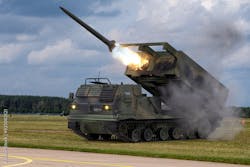Lockheed Martin to build missile launchers for advanced guided and unguided rockets on the battlefield
REDSTONE ARSENAL, Ala. – U.S. Army ground warfare experts are asking Lockheed Martin Corp. to continue full-rate production of the Guided Multiple Launch Rocket System (GMLRS) missile launcher under terms of a $332.1 million order announced earlier this month.
Officials of the Army Contracting Command at Redstone Arsenal are asking the Lockheed Martin Missiles and Fire Control segment in Grand Prairie, Texas, for full-rate production of the GMLRS missile launcher, which an fire guided and unguided projectiles at targets as far away as 26 miles.
The system also can fire the Army Tactical Missile System (ATACMS) at targets as far away as 190 miles, as well as the future Precision Strike Missile (PrSM), which can attack land and sea targets from distances as far as 300 miles.
The rocket-based artillery system also can fire its munitions quickly and the move away to avoid counter-battery fire. The GMLRS carries its guided munitions in pods that contain six rockets. Each system carries two pods that must be loaded by hand. GMLRS can fire all of its 12 munitions in less than a minute.
The system's alternative-warhead rocket is a large airburst fragmentation warhead that explodes about 30 feet over a target area to disperse solid-metal penetrating projectiles to destroy enemy soldiers, armored vehicles, command posts, and other battlefield targets. This version has been in production since 2015.
The long-range GMLRS unitary-warhead rocket is a GPS-guided munition with a 200-pound high-explosive warhead that can be used on open battlefields and in urban areas. Its guidance system enables the rocket to avoid causing collateral damage, and enables GMLRS crews to fire fewer rockets.
The unitary-warhead GMLRS rocket has a multi-mode fuse for point detonation, delay detonation, and proximity detonation to attacking soft targets, lightly fortified bunkers, and enemy personnel in the open.
On this contract Lockheed Martin will do the work at locations to be determined with each order, and should be finished by October 2027. For more information contact Lockheed Martin Missiles and Fire Control online at www.lockheedmartin.com/en-us/products/guided-mlrs-unitary-rocket.html, or the Army Contracting Command-Redstone at https://acc.army.mil/contractingcenters/acc-rsa/.
About the Author
John Keller
Editor-in-Chief
John Keller is the Editor-in-Chief, Military & Aerospace Electronics Magazine--provides extensive coverage and analysis of enabling electronics and optoelectronic technologies in military, space and commercial aviation applications. John has been a member of the Military & Aerospace Electronics staff since 1989 and chief editor since 1995.
